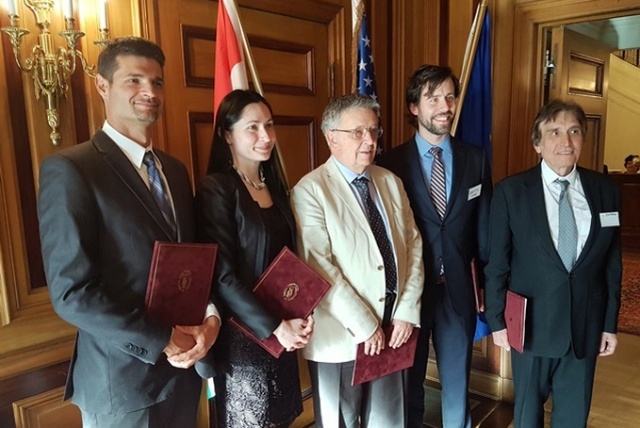MTA American-Hungarian Committee established
With the participation of four United States-based Hungarian scientific organisations and with support from the Hungarian Academy of Sciences, a new trans-border academic body has been established. The related agreement was signed at the Embassy of Hungary in Washington, D.C., on 6 April, where the Academy was represented by President László Lovász.
23 April, 2018
The American-Hungarian Committee of the MTA (MTA AMB) acts as an umbrella organisation, where the main aim will be strengthening links between Hungarian scientists living in the United States, the Academy’s American public body members and the Academy itself.
 Signatories of the Washington agreement from left to right: Miklós Czaun, president, US West Coast Club of Hungarian Scientists; Margit Szabari, Organizer of the Science Club at the Hungarian Society of Massachusetts; László Lovász, president, Hungarian Academy of Sciences; Imre Bartos, president, New York Hungarian Scientific Society; László Záborszky, president, Association of Hungarian-American Academicians Photo: Károly Kocsis
Signatories of the Washington agreement from left to right: Miklós Czaun, president, US West Coast Club of Hungarian Scientists; Margit Szabari, Organizer of the Science Club at the Hungarian Society of Massachusetts; László Lovász, president, Hungarian Academy of Sciences; Imre Bartos, president, New York Hungarian Scientific Society; László Záborszky, president, Association of Hungarian-American Academicians Photo: Károly Kocsis To this end, the new organisation will liaise and collaborate with the Academy, as well as its American public body members and the Academy’s national and international regional committees and councils. It will also keep an up-to-date record of external and honorary members as well as full and corresponding members who normally reside in the United States. Furthermore, it will strive to increase the number of public body members and support closer ties between the MTA and Hungarian-American scientists. Additionally, the organisation will support the scientific activity of young Hungarian scientists and organise scientific meetings, symposia, conferences, trainings and lectures. It will distribute the results of United States-based Hungarian scientists while supporting their cooperation with other scientific organisations. At the request of the Academy, the committee will act as an intermediary in the creation of expert opinions and the selection of American specialists for the expert bodies of the Academy.
Within the MTA’s framework, the Hungarian Science Abroad Presidential Committee (MTK EB) was set up in 1996, and four years later, in 2000, the Academy’s public body opened up for scientists living outside Hungary who declare themselves (partly) Hungarian. MTA AMB is already the fifth trans-border body linked to the Hungarian Academy of Sciences: the Regional Committee in Cluj (KAB) was founded in 2007; the Vojvodinian Hungarian Academic Council (VMAT) in 2008; the Academic Council of Hungarians in Slovakia (SZMAT) in 2013; and the Hungarian Academic Council of Transcarpathia (KMAT) in 2015.
In addition to academic committees and councils operating in the neighbouring countries, the creation of a forum on academic public body activity for scientific communities which are geographically distant and work in close cooperation with researchers in Hungary was justified.
MTA AMB was established on the initiative of the Association of Hungarian-American Academicians (AMAT). Among its founders, we can find the Boston Hungarian Science Club and the Hungarian Society of Massachusetts (BAMT), the New York Hungarian Scientific Society (NYMTT), and the US West Coast Club of Hungarian Scientists (NYPMT).
MTA AMB primarily operates for the benefit of the Academy’s full, corresponding, external and honorary members habitually residing in the territory of the United States and of its external public body members living in America, respectively, so that the exercise of certain rights and obligations belonging to them derived from their public body membership can be ensured.
The president changes on a biennial rotational basis, following the alphabetical order of the Hungarian names of the organisations: AMAT, BAMT, NYMTT, and NYPMT. Accordingly, the president of MTA AMB between 2018 and 2020 is the president of AMAT, who is currently brain researcher László Záborszky, external member of MTA. Should the president of an organisation not be a member of the Academy, the given organisation chooses an academician for the post of president of MTA AMB.
